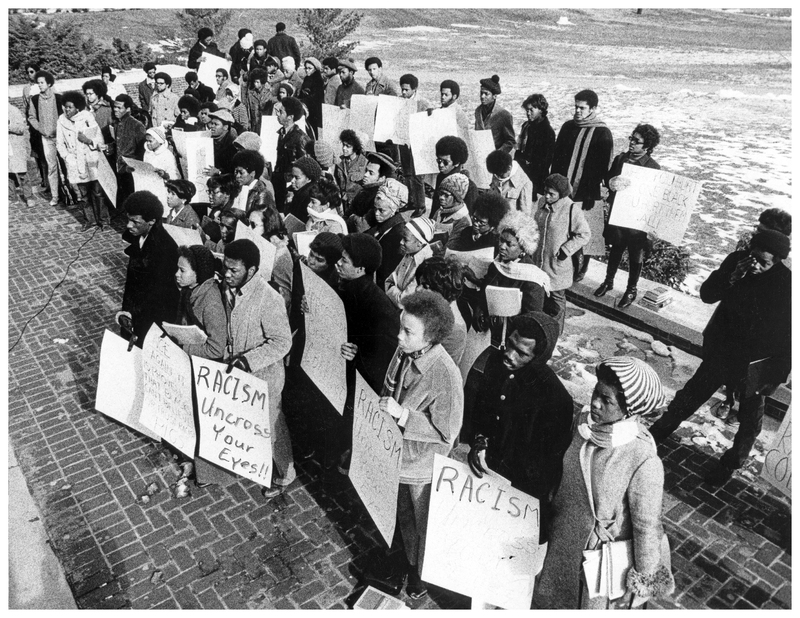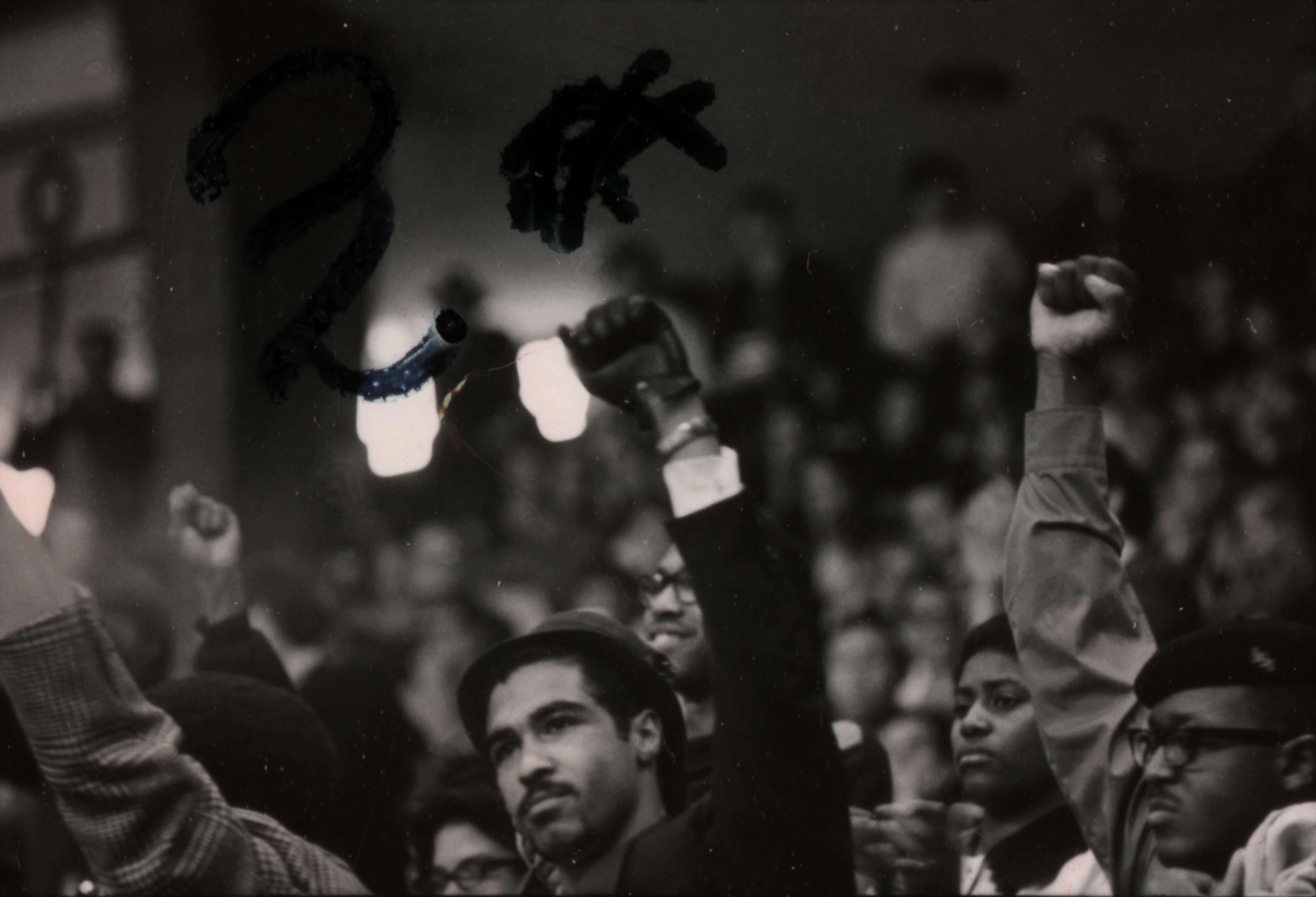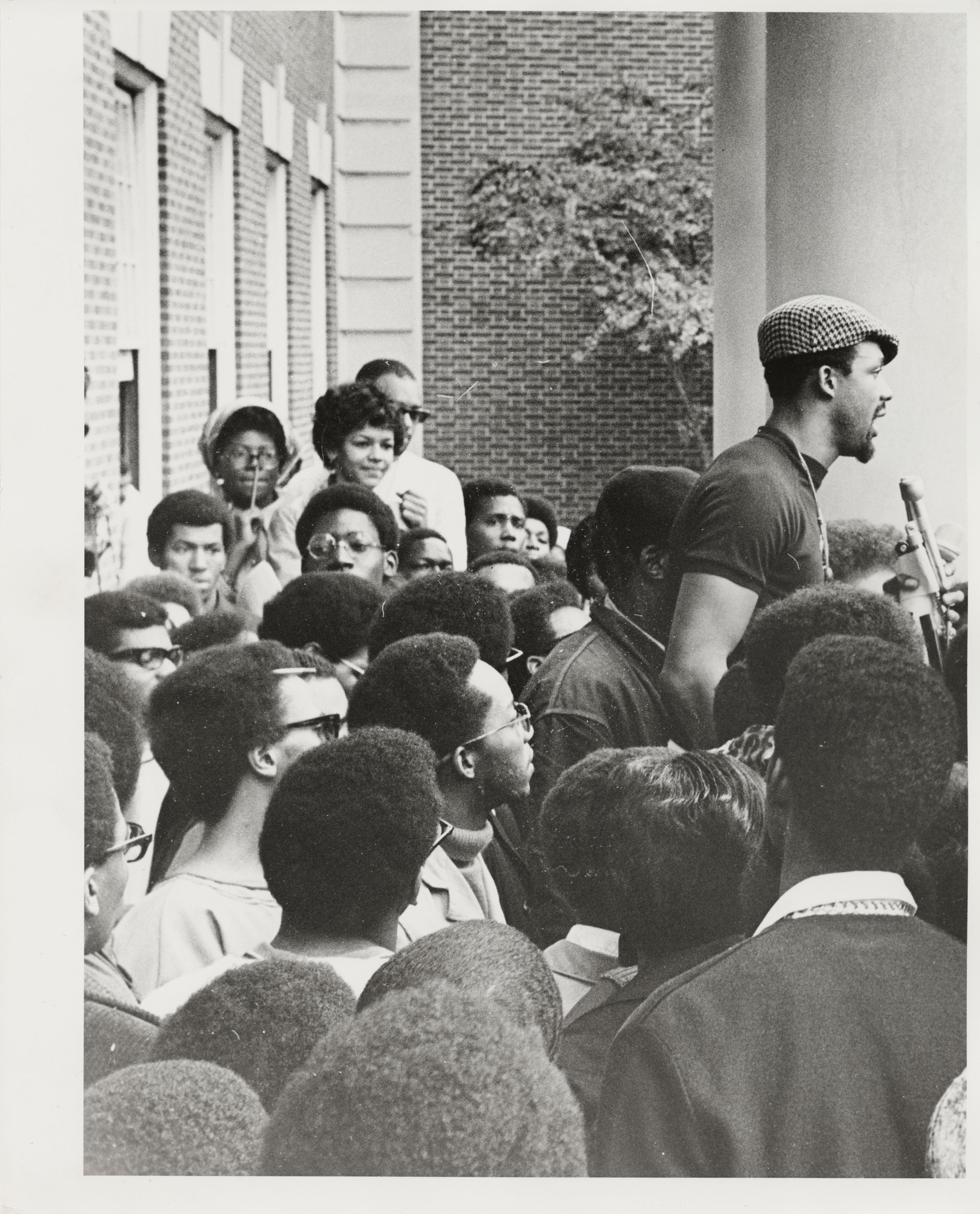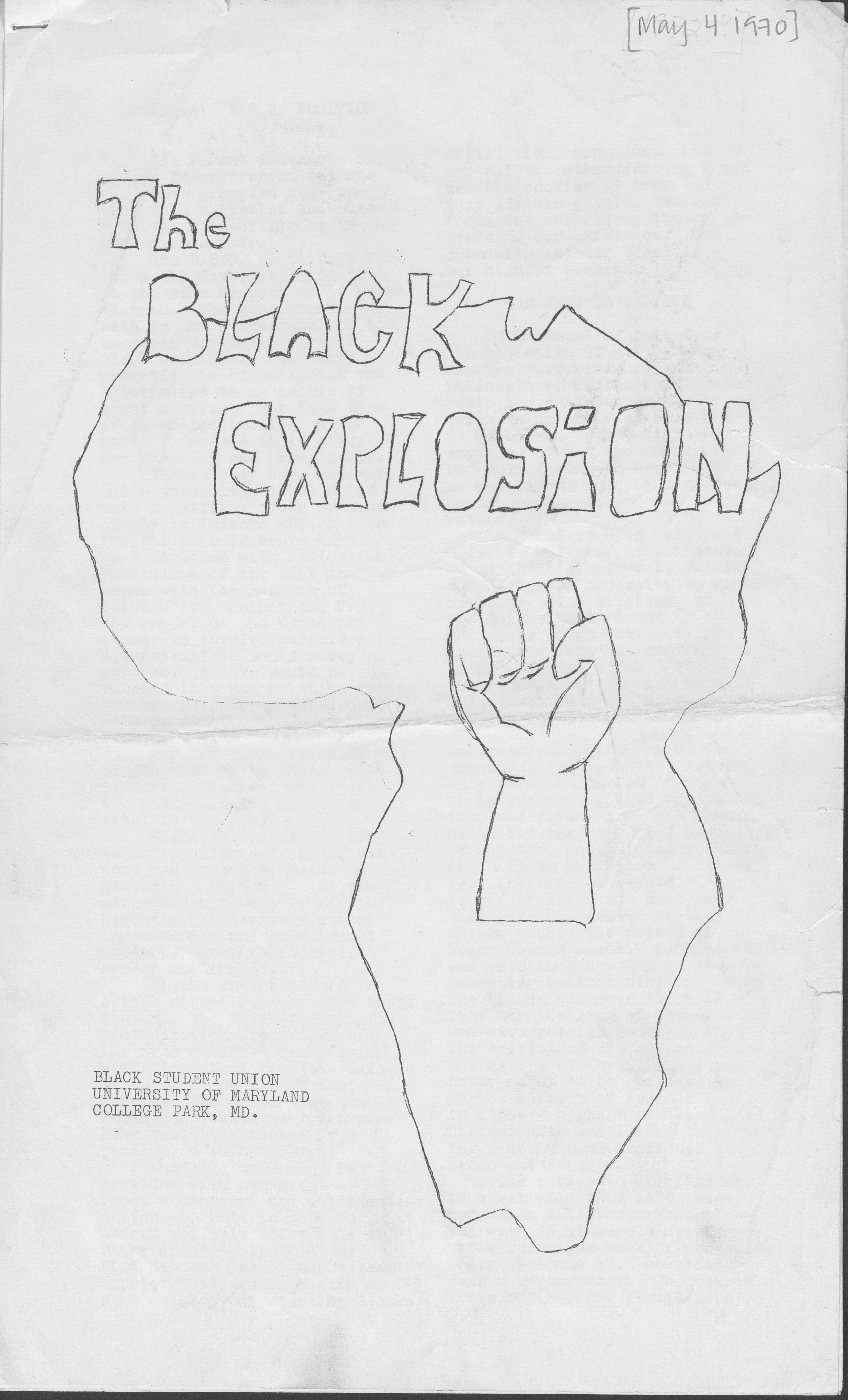Process and Reflection
This project's contours were shaped by absence and uncertainty. Because we began this class project in the midst of a brutal health crisis, much of our work time ended up focusing on our process, and on what would necessarily be missing from ours. As we pivoted from aspirational to realistic, we had the opportunity to look at the important gaps in our research and exhibition design, particularly around race and archival power.
Our reflections and suggestions for future research follow.
Co-Creation as a Starting Point
One of the most important limits in how this project unfolded is that it has not yet been informed by consultation or collaboration with Black Student Union alumni and current members. Under better conditions, these perspectives and potential work together would have been a natural and necessary starting point for a project about the activism and legacy of previous BSU members at UMD. The process of building the exhibit could also benefit from an understanding of current BSU priorities and recent work, and could ideally complement or support BSU work already underway or completed.
Co-creation involves relationship-building, time, energy, significant communication, and additional labor, even under the "best" conditions. With so many students, including ourselves, experiencing relocation, fear, and loss due to COVID-19 in the first two months of the project, we did not see it as a respectful or possible time to initiate any consultation or co-creation processes. In lieu of that, we have left an open invitation for the current BSU to use any resources we gathered or built during this process if it would be useful to their work down the line.
As you view the exhibit timeline... What do you imagine as the challenges and potential benefits of co-creation? Why is it important to start research and exhibit development with communities most connected to, or impacted by, the issues at hand?

Reliance on Incomplete Sources
Working within the COVID-19 pandemic, our inability to conduct original interviews (with BSU members and alumni) and a lack of full archival access meant that we relied heavily on the online archive of the Diamondback, UMD's student-run newspaper. On one hand, this digital archive provided a wealth of details about the BSU protests in 1968, but on the other hand, it was almost always written by white writers, and the publication itself has made numerous racist decisions during its 110-year history. As we began our exhibition process, the Diamondback retrospectively acknowledged and documented these problems.
As you read through the articles on our timeline... Where do you see the presence and absence of various Black student voices? Why is it important to hear directly from people involved or present in a historical event? What perspective do you think those could have added to this exhibit?
Does it matter who writes articles about racial injustice and racism? Why or why not? How can the culture of a newsroom influence what is or is not remembered and acknowledged historically? Why does it specifically matter for Black voices to exist /narrate/create archives?

Racial and political contexts matter
Language and racial political contexts change over time, and we need to pay attention to that as researchers and as the audience.
The BSU protests arose from assertions about racial genetic differences between Black women and white women, with the BSU challenging the university to prove that difference. In building this exhibit, we understand race in this context as a social category that creates specific and inequitable experiences for Black people and people of color in a system of white supremacy.
Political contexts matter as well. For example, it can be helpful to remember that in 1968, Black and Brown armed resistance was part of the larger national context in the U.S.

Language & Capitalization
Language is political and has specific meanings. For this exhibit, we intentionally choose to capitalize “Black” as an identity and racial category, following the BSU’s current usage in 2020. While our usage does not always adhere to official recommendations (such as the AP style guide), for us community use must be centered. We also recognize that individual capitalization of the word Black, as well as the use of other terms such as “African-American”, varies widely, and reflects cultural values, geographical experiences and generational differences.
Local UMD Campus Focus
Our choice to focus at a hyperlocal scope stems from a desire to surface nuanced details about the BSU protests at UMD, while also connecting to parallels in the national narrative and context.
Archival Gaps, Always
While noting the impacts of COVID-19 closures on our research process, we also find it important to note that an archive is always incomplete, and will often support what those in power have deemed valuable to preserve at any given time.
Part of our motivation to begin a project like this was to gather what archival materials we could, to uplift a significant student activism event on campus that challenged this very type of power.
For Future Researchers

Due to the pandemic, Special Collections and University Archives in Hornbake Library closed during the discovery stage of this exhibit as we began compiling archival material. Considering this, we have included links and descriptions of the various collections within University Archives that we intended to explore for this exhibit. We implore those drawn to this exhibit to continue exploring these issues using the following archival collections.
The Board of Regents records contains correspondence; statements; proposals; reports; and files from specific committees, boards, and commissions. The University also holds a significant unprocessed addition to the records which includes correspondence, publications, audiotapes, minutes of meetings, budgets, and reports. Specifically, we would have examined the minutes of meetings between December 15, 1967, and June 20, 1969, available to be requested here.
Office of the Chancellor records
The Office of the Chancellor was created in 1970 in the course of the reorganization of the University of Maryland system. The Chancellor was the highest-ranking administrator for the College Park campus until the expansion of the University of Maryland in 1988, at which time the office was renamed Office of the President. The records consist of the administrative files of the Chancellor and include reports, financial and budget records, committee and task force files, publications, and working papers. These records likely contain correspondence surrounding many of the incidents highlighted in this exhibit.
History of the University of Maryland - Campus Unrest records
These records include photographs and documents from the Vietnam War protests at the University of Maryland between 1970 and 1972. Photographs capture demonstrations, police activity, arrests, and destruction, both on- and off-campus, caused by the protestors. Documents include posters, news clippings, and recollections of the protests by students. While the majority of the material in this collection is from 1970-1972, the collection provides context into the tension and turbulence on campus at the time.
Office of the President, University of Maryland records
These records include correspondence, publications, reports, minutes, invitations, legislation, legal and financial records, photographs, newspaper clippings, conference materials, class schedules, and committee files. University Archives also holds a large unprocessed addendum, consisting of one series documenting the administration of Wilson H. Elkins. These files primarily include correspondence, reports, budgetary materials, minutes, committee files, photographs, maps, and blueprints. The unprocessed papers contain a wealth of material relating to campus unrest, including official statements by Elkins and then-Governor Marvin Mandel. The unprocessed collection of President Elkin's papers also include extensive correspondence surrounding both the College of Home Economics and the Black Student Union.
Division of Student Affairs records
These records consist of administrative materials, committee and commission files, and budgetary records as well as files related to student organizations, housing, the Counseling Center, health services, and the dining hall. In 1970, the department was changed to the "Office of the Vice Chancellor for Student Affairs." The records also include a number of files related to the activities and publications of Students for a Democratic Society (SDS), a national organization largely focused on opposition to the Vietnam War. Also included are more general files dealing with on-campus demonstrations and protests. Specifically, series five likely contain material directly related to issues explored in this exhibit.
University Senate (1920-1970) records
These records consist of the minutes of the Senate as well as materials relating to its various committees and task forces. In series four, there are nine folders on disciplinary matters, containing such documentation as the university's policy towards demonstrations; minutes of the Committee on Student Discipline; a proposal to strengthen disciplinary procedures and
regulations and written comments about the proposal. It also includes newspaper clippings about the proposal and students in court because of protest activity.

University Publications (UPUBs)
The collection of University Publications contains a wide variety of student publications, spanning much of the history of the university. Several publications contain extensive coverage of Campus Unrest and protests at the time, as well as the Black Student Union:
Increasingly radicalized student magazine published from 1966 to the early 1970s. Argus published a number of stories and photographs relating to student protests on campus, and the general campus climate.
Since 1968, the Black Explosion has offered information and updates about campus affairs and student life, especially pertaining to the Black community. Black Explosion began as the student publication of the Black Student Union, a central focus of this exhibit. Archival issues of Black Explosion are available online, beginning in May 1970. Current issues of Black Explosion can be found here.
The student newspaper of the University of Maryland, found online in the UMD student newspaper database, was the main resource for this exhibit. The Diamondback includes extensive coverage of events covered in this exhibit.
Radical Guide to the University of Maryland
This one-time publication was issued by the Democratic Radical Union of Maryland (D.R.U.M.)
in the fall of 1970 to provide guidance to the radical student and replace the M Book that had been censored by the administration. The graphic, relatively subversive guide provides context into the campus climate and tensions around campus unrest at the time.
University of Maryland Vertical File Collection
The University of Maryland Vertical File collection contains newspaper clippings (text and photographs) from the Washington Post, Baltimore Sun, Diamondback, and other papers grouped under subject headings. Specifically related to this exhibit, there are folders for the Black Student Union, and several folders on campus unrest. There is also a folder for the College of Home Economics, which could contain information about the Black Student Union protest, or the nutrition study students protested against.
Photo Credits
Photo 1: UMD Black Student Union, 1970. Courtesy UMD University Archives
Photo 2: 1971 Rally for a Black Studies Program at UMD. Source: Washington Spark
Photo 3: Raised fists at UMD 1969 convocation, directly referencing the 1968 Olympics Black power salute. Courtesy UMD University Archives
Photo 4: 1968 Black Student Union protest at UMD. Courtesy UMD University Archives
Photo 5: UMD Campus sits empty due to COVID-19. Source: Maryland Today
Photo 6: Black Explosion Now Available! 1970. Source: Terrapin Tales